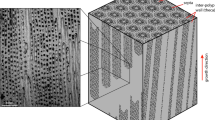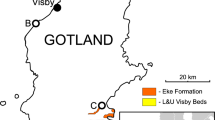Abstract
Scanning electron microscopy, field studies using dyes which become incorporated into the skeleton of living corals as time markers, and petrographic and mineralogic techniques were used to describe the diel pattern of calcium carbonate accretion in the extending axial corallite ofAcropora cervicornis. The axial corallite extends by the formation of randomly oriented fusiform crystals at the distal tip of the branch. Morphological and mineralogical characteristics suggest that these might be calcite crystals. They form a framework upon which needle-like aragonite crystals (initially small tufts) begin to grow. As the needles elongate, groups of them form well defined bundles, fasciculi, which compose the primary skeletal elements. There is a diel pattern in the deposition of the skeleton. At night (1800–0600 hours) the distal spines are pointed and composed primarily of fusiform crystals. During the day (0600–1800 hours) mineral accretion occurs on all surfaces of the skeleton, apparently by epitaxial growth on the aragonite needles of the fasciculi.
Similar content being viewed by others
References
Barnes DJ (1970) Coral skeletons: an explanation of their growth and structure. Science 170:1305–1308
Barnes DJ (1972) The structure and function of growth ridges in scleractinian coral skeletons. Proc R Soc Lond [Biol] 182:331–350
Barnes DJ, Crossland CJ (1978) Diurnal productivity and apparent14C-calcification in the staghorn coral,Acropora acuminata. Comp Biochem Physiol [A] 59:133–138
Barnes DJ, Crossland CJ (1980) Diurnal and seasonal variations in the growth of a staghorn coral measured by time-lapse photography. Limnol Oceanogr 25:1113–1117
Bryan WH, Hill D (1941) Spherulitic crystallization as a mechanism of skeletal growth in the hexacorals. Proc R Soc Queensl 52:78–91
Chalker BE (1975) Calcification, metabolism and growth by the staghorn coral,Acropora cervicornis. Ph D dissertation, University of Miami
Chalker BE (1977) Daily variation in the calcification capacity ofAcropora cervicornis. Proc 3rd Int Coral Reef Symp 2:417–423
Garside J (1982) Nucleation. In: Nancollas GH (ed) Biological mineralization and demineralization. Springer Berlin Heidelberg New York, pp 23–36
Gladfelter EH (1982) Skeletal development inAcropora cervicornis. I. Patterns of calcium carbonate accretion in the axial corallite. Coral Reefs 1:45–51
Goreau TF (1959) The physiology of skeleton formation in corals. I. A method for measuring the rate of calcium deposition by corals under different conditions. Biol Bull 116:59–75
Goreau TF (1963) Calcium carbonate deposition by coralline algae and corals in relation to their roles as reef-builders. Ann NY Acad Sci 190:127–167
Houck JE, Buddemeier RW, Chave KE (1975) Skeletal low-magnesium calcite in living scleractinian corals. Science 189:997–999
Kitano Y, Hood DW (1965) The influence of organic material on the polymorphic crystallization of calcium carbonate. Geochim Cosmochim Acta 29:29–41
Kitano Y, Kanamori N, Yoshioka S (1976) Influence of chemical species on the crystal type of calcium carbonate. In: Watabe N, Wilbur KM (eds) The mechanisms of mineralization in the invertebrates and plants. Univ South Carolina Press, pp 191–202
Kobayashi S, Taki J (1969) Calcification in sea urchins. I. A tetracycline investigation of the growth of the mature test inStrongylocentrotus intermedius. Calcif Tissue Res 4:210–223
Macintyre IG, Towe KM (1975) Skeletal calcite in living scleractinian corals: microboring fillings, not primary skeletal deposits. Science 193:701–702
Milliman JD JD (1974) Marine carbonates. Springer, Berlin Heidelberg New York
Neckelmann NS (1982) Regulation of numbers of symbiotic algae in the digestive cell ofHydra viridis. Ph D dissertation, University of California, Los Angeles
Sverdrup HU, Johnson MW, Felming RH (1942) Oceans, their physics chemistry and general biology. Prentice Hall, Engelwood Cliffs NJ
Towe KM, Malone PG (1970) Precipitation of metastable carbonate phases from seawater. Nature (London) 226:348–349
Vandermeulen JH, Davis ND, Muscatine L (1972) The effect of inhibitors of photosynthesis on zooxanthellae in corals and other invertebrates. Mar Biol 16:185–191
Vandermeulen JH, Watabe N (1973) Studies on reef corals I: skeleton formation by newly settled planula larvae ofPocillopora damicornis. Mar Biol 23:47–57
Wainwright S (1964) Studies of the mineral phase of the coral skeleton. Exp Cell Res 34:213–230
Author information
Authors and Affiliations
Rights and permissions
About this article
Cite this article
Gladfelter, E.H. Skeletal development inAcropora cervicornis . Coral Reefs 2, 91–100 (1983). https://doi.org/10.1007/BF02395279
Received:
Accepted:
Issue Date:
DOI: https://doi.org/10.1007/BF02395279




